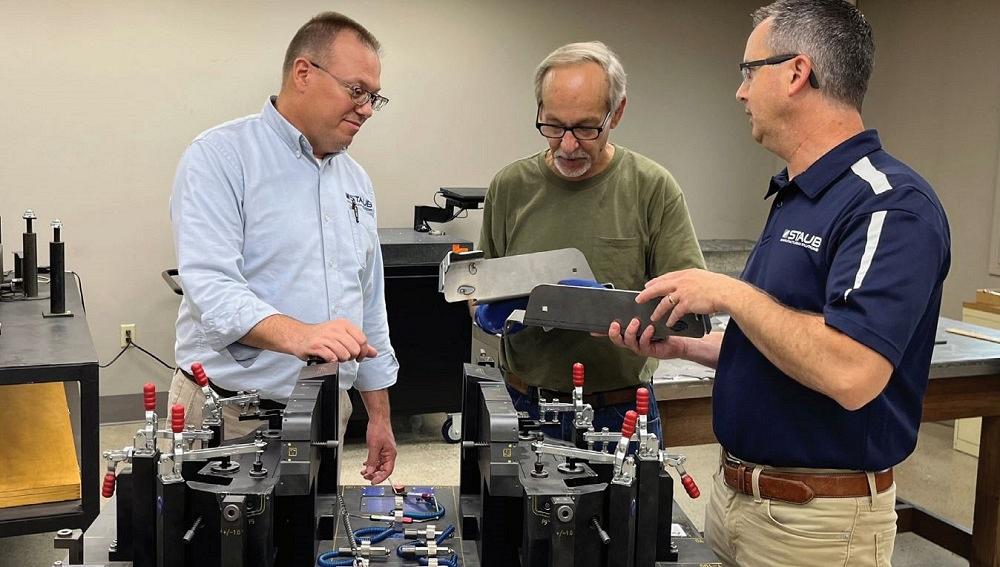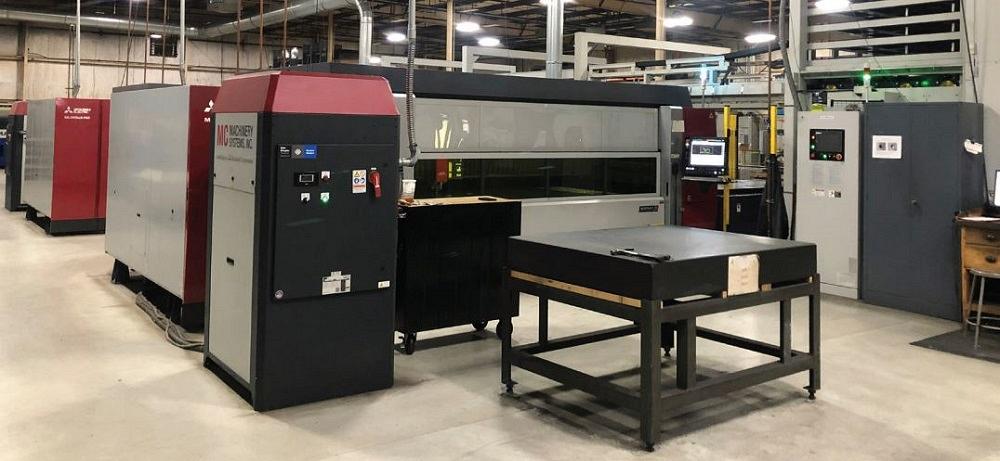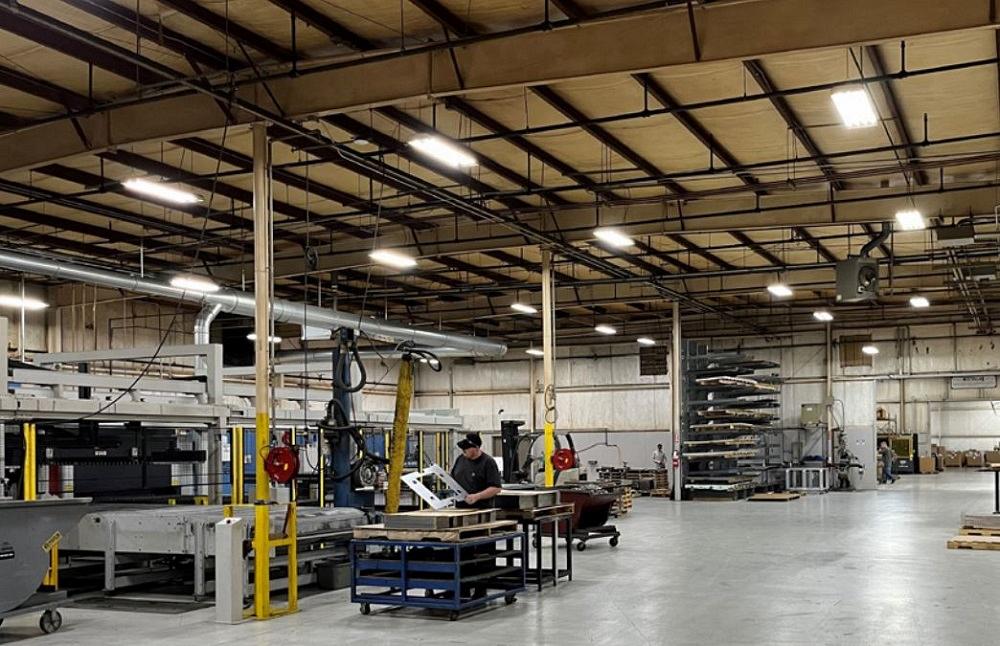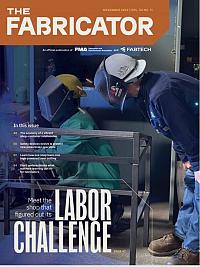Senior Editor
- FMA
- The Fabricator
- FABTECH
- Canadian Metalworking
Categories
- Additive Manufacturing
- Aluminum Welding
- Arc Welding
- Assembly and Joining
- Automation and Robotics
- Bending and Forming
- Consumables
- Cutting and Weld Prep
- Electric Vehicles
- En Español
- Finishing
- Hydroforming
- Laser Cutting
- Laser Welding
- Machining
- Manufacturing Software
- Materials Handling
- Metals/Materials
- Oxyfuel Cutting
- Plasma Cutting
- Power Tools
- Punching and Other Holemaking
- Roll Forming
- Safety
- Sawing
- Shearing
- Shop Management
- Testing and Measuring
- Tube and Pipe Fabrication
- Tube and Pipe Production
- Waterjet Cutting
Industry Directory
Webcasts
Podcasts
FAB 40
Advertise
Subscribe
Account Login
Search
How metal fabricators can improve customer partnerships
It comes down to cost, capability, and, not least, shop culture
- By Tim Heston
- November 6, 2023
- Article
- Shop Management

Staub shop managers review a customer order, discussing the fixturing concepts for automated welding. Steve Staub, company president, is on the left.
At the FABTECH show in Chicago, Steve Staub sat at a table not far from the conference sessions. The president of Staub Manufacturing Solutions, a custom metal fabricator in Dayton, Ohio, was with other company managers and owners, talking shop. They discussed broken supply chains and shared horror stories. Yes, the pandemic played a part, but was it just the straw that broke the camel’s back? What were the root causes—really?
The group at FABTECH had just emerged from Staub’s conference presentation, which got to the root of the matter.
“We’ve been in business for more than 25 years,” Staub said in a separate interview with The Fabricator. “Just like anyone else, we’re only as good as our suppliers are. You could be an OEM making trucks or a small product manufacturer or a job shop. If you can’t receive components reliably and correctly, you’re going to have trouble supplying your end customer.
“So, we documented this. How do we improve our supply chain? We realized it boiled down to three things. The first two are givens, cost and capability. Beyond those, we discovered that it all really came down to culture.”
Cost, capability, and culture are like three legs of a stool. Shortcomings in one area can throw the other two off kilter, which in turn leads to late deliveries, quality problems, and more headaches. Maintain all three, and both customer and supplier can grow together.
What’s the Real Cost?
At the heart of cost issues lies a lack of transparency, which includes material price fluctuations. Staub recalled communicating regularly with customers as material prices increased over the past few years. That said, he doesn’t just call when material prices rise.
“It’s about being transparent,” Staub said. “We worked with a project recently where the material price went down. So, we called the customer and gave them a lower price based on the new material costs. Some might continue to run the job and charge the same material rate, but that’s not a real partnership with your customer. And they’ll find out [about the material price drop] eventually anyway.”
Of course, there’s more to cost than the material, and if a bid looks too good to be true, it probably is. It’s an old story. The customer accepts the lowest bid and pays the price—that is, that initial quoted price, plus all the costs for production delays, miscommunication, and other unmet promises. A low-ball bid might be $21,000, the highest $26,100. The customer goes with the lowest bid, but production delays and rework increase the customer’s internal costs by $6,800. So, the true cost was $27,800—higher than that highest bid that was quoted originally. Goodbye savings. In a sense, delivery performance is one contributing factor behind cost. Less predictable delivery of quality products ultimately will cost more.
“This actually represents a real situation we faced,” Staub said. “Our bid was in the middle of the range. But when the customer went with the lowest bidder, it ended up costing more in the end. Eventually, when the customer went out to look for other suppliers, we ended up winning the job.”
Staub added that there’s more to this conundrum than the math calculating immediate costs. What opportunities were missed because the company was dealing with all the hassle and frustration that low-ball supplier caused? Production delays add uncertainty, and enough uncertainty creates chaos. That’s not the greatest work environment, so turnover increases, and company culture deteriorates. All this stems from poor customer-supplier relationships.

A production job is staged at Staub Manufacturing. A visit to the shop floor can reveal the kind of work the fabricator specializes in. Images: Staub Manufacturing Solutions
Of course, how can a customer really know the lowest bidder won’t be able to deliver? Yes, the company might be low-balling because it’s desperate for work. But we also live in an age of rapidly evolving manufacturing technology, both in software and machinery. That low bidder might just be the most well-run, leanest operation in the area—a “disrupter,” to use Big Tech parlance. How can you tell? It’s time for a visit.
Seeing Is Believing
From afar, you can look at an equipment list and parts catalog on a website, and you can talk with a shop’s sales representatives. That laser can cut this thick; that press brake can form these bends; these welding processes can complete these joints.
And if sales or quoting representatives bring up technical details, that’s a plus. They might talk of tooling interference or radius issues in bending, access or fastener availability issues in hardware insertion, distortion in welding, or edge quality concerns in cutting. Discussing such detail from the start might be a sign that jobs aren’t just “thrown over the wall” for people in production to figure out.
Still, sales engineers won’t bring up technical issues if there aren’t any of significance to discuss, and some issues just don’t reveal themselves in the quoting stage. A phone conversation only tells you so much. Seeing is believing, and to truly uncover a fabricator’s operational prowess, a visit is in order.
If the shop’s a mess, that’s a bad sign. Of course, the shop could have been cleaned just before your arrival, so tidiness for a customer visit doesn’t always reflect reality.
During the tour, ask about the shop’s technology and watch for old machinery. “The machinery should be able to keep up with you as you grow,” Staub said. “You as an OEM don’t want to keep looking for new suppliers every year. Is the fabrication supplier investing in equipment and technology to keep up with increasing workloads? It’s about suppliers growing with their customers.”
He added that this includes equipment reliability. “Pay attention to the service record,” Staub said. Records of extensive preventive maintenance can be a good sign—but excessive reactive maintenance (unexpected downtime), not so much. “New technology is great, but it needs to be reliable.”
A visit also can reveal how a shop manages part flow and where its sweet spot really is. Does the shop specialize in production or prototypes and small-quantity jobs?
Staub added that his shop’s sweet spot is in production work, not quick-turn, low-quantity orders and prototypes. This becomes evident by the company’s raw stock strategy. “We don’t keep thousands of 0.25-in.-thick carbon in stock just in case someone calls,” Staub said. “We’re not set up for that low-quantity, quick-turn work, but there are a lot of shops that are.”
He added that approaches to job mixes (prototype versus production) vary here; it really depends on a fabricator’s operational and business strategy. But a long-term partnership between supplier and fabricator requires each to be a good fit for the other, so asking questions about a fabricator’s sweet spot certainly doesn’t hurt.
During your visit, review quality metrics, see work samples, and gain insights on how information flows through the operation. How does the fabricator receive, inspect, identify, and store raw stock? Is WIP controlled? Is it sitting on a shelf or moving on a cart or fork truck? Is it clear where the work is headed and where it’s going? Are metric boards clearly visible and (most important) current?
Also, how are orders processed? As Staub explained, a paperless workflow can be a good sign, especially if shops need to react quickly to job changes. But the order-processing procedure itself needs to have good bones too. What systems are in place to ensure workers pull up the right order at the right time?
“That’s great that you’re scanning work as you start an order,” Staub said, referring to a paperless setup where workers scan a work ticket on a pallet of parts by a machine. “Still, what processes are in place to make sure that person is running the right job? There are plenty of variables here, but it’s not brain surgery either.”
Also look at a fabricator’s data collection practices. How long do setups actually take, and is that time tracked? The same goes for parts offloading from the laser, changeover time at the robotic welding cell, and so on—really everything from material inspection at the receiving dock to the final packaging at the shipping dock. Time is money, and because both setup and material handling take time, they need to be tracked.
“So many companies don’t capture everything, so they don’t know what their true costs are,” Staub said. “We’ve got shop software like most people do, but everyone has an iPad so they can capture the data we need, including the problems and the improvements they make. This also helps us know what our true costs are.”
This includes quality—that is, how and when work is inspected, and by whom. Do operators check first articles and certain pieces with calipers or other devices? Where’s the quality information recorded, and how is it correlated with other job-related information?
Staub conceded that, yes, in an ideal world, ISO 9000 and other certifications would guarantee that a company has good systems in place. But, of course, having a certificate doesn’t guarantee that a supplier is a good fit. A supplier-customer partnership is a relationship between people—hence the importance of the third leg of Staub’s stool: culture.
Can You Measure Culture?
As Staub explained, achieving concrete measurements of “culture” can be difficult, but you can look for certain signs. How do people interact? How engaged and knowledgeable are front-line workers?
Also, look out for safety and ergonomics. Are there slip hazards? Are machines safeguarded properly with light curtains, hard guarding, or other devices? Are operators heaving around large workpieces, or do they have assistance—additional personnel, lift-assist devices, or both? How comfortable is the shop floor environment? Is it a clean, organized environment?
Another puzzle piece: Observe how the shop deals with mistakes. Does it hide them and reprimand those who made them, or does it use them to educate and improve?

An automated blanking system at Staub cuts parts that are delivered to downstream forming and welding. Note the clean workspace.
“We have records of our mistakes hanging in our QA room, for everyone to see,” Staub said. “It has the job number, what was wrong, who did it, and how the problem was resolved.”
Seeing scrapped pieces might not be a bad sign, as long as the operation uses them to improve. The most experienced brake operator can form a flange upside down, even if the control shows him a 3D simulation of the part, tooling, and backgauge position. People aren’t perfect, and that’s OK. Such transparency also helps maintain accountability. When mistakes happen, people know when and how they happen and, yes, who made them.
“We have three things that we focus on at our company,” Staub said. “Follow the process, take responsibility, and improve everything. Everyone makes mistakes, but if you do make a mistake, take responsibility and work to improve it.”
Transparency overall is a sign that a shop culture is healthy. If you see shop personnel talking with quoting, purchasing, and programming personnel, that’s a good sign. They’re working not just to clock in and clock out, but to achieve a defined vision centered around operational excellence. They’re not just a cog in a wheel, mindlessly moving forward and never questioning the status quo. Good communication creates less frustration on the floor, which in turn attracts better employees—all ingredients of a healthy shop culture.
All this leads to less employee turnover. As Staub put it, “If you spend all your time dealing with high turnover, rehiring and retraining, you’re never going to have the right team in place to make good parts.
“You spend more waking hours with the people you work with than those in your own family,” Staub continued. “You need to have the right people that create the right culture, with everyone working together to make things better.”
Beyond all this, simply asking a question about shop culture directly can give some insight: What’s the culture like? Staub emphasized the “what.” When a visitor asks workers if the culture is good or not, they’ll probably just say the culture’s great. But if you ask front-line workers to describe the culture, their answers (or lack thereof) can be telling.
“Talk to the team members who are running the machines. Ask what the culture’s like and what the values are,” Staub said. “If they can’t tell you, that can be a red flag.”
Price Isn’t Cost
Think of all these observations about cost, capabilities, and culture as a hunt for good ingredients. You can’t have a great meal without them, but they also have to be put together in the right way. The best ingredients still lose their taste if they’re cooked badly.
In the manufacturing context, missing or badly cooked (managed) ingredients lead to transparency issues, which in turn leads to overpromising and underdelivering. The ensuing chaos shrouds the actual job costs—not just material cost, but the cost of handling, setup, rework, consumables, overtime, and more. Unpredictability—in setup times, run times, handling times, or outside services like coating and plating—sends ripples up and down the manufacturing value stream, making life harder for everyone.
When an operation doesn’t have a handle on its true costs, the shop floor remains a black box where workers muscle jobs through the best they can. Shops price what the market will bear and hope for the best.
“For some, low-balling is part of their pricing strategy, to draw new customers in, and then they try to make it up on future work,” Staub said. “I never have understood that. Just try to be fair and honest with customers, offer a fair price, and make sure the experience is successful for everyone.”
It boils down to the basic fact that a business without margins is unsustainable. The same goes for a company that can’t predict what those margins will actually be. If two legs of the stool—culture and capability—are managed well, the third leg—cost (which includes delivery performance)—becomes predictable. That, Staub said, builds the foundation of a thriving customer-supplier partnership.
About the Author

Tim Heston
2135 Point Blvd
Elgin, IL 60123
815-381-1314
Tim Heston, The Fabricator's senior editor, has covered the metal fabrication industry since 1998, starting his career at the American Welding Society's Welding Journal. Since then he has covered the full range of metal fabrication processes, from stamping, bending, and cutting to grinding and polishing. He joined The Fabricator's staff in October 2007.
Related Companies
subscribe now

The Fabricator is North America's leading magazine for the metal forming and fabricating industry. The magazine delivers the news, technical articles, and case histories that enable fabricators to do their jobs more efficiently. The Fabricator has served the industry since 1970.
start your free subscription- Stay connected from anywhere

Easily access valuable industry resources now with full access to the digital edition of The Fabricator.

Easily access valuable industry resources now with full access to the digital edition of The Welder.

Easily access valuable industry resources now with full access to the digital edition of The Tube and Pipe Journal.
- Podcasting
- Podcast:
- The Fabricator Podcast
- Published:
- 04/16/2024
- Running Time:
- 63:29
In this episode of The Fabricator Podcast, Caleb Chamberlain, co-founder and CEO of OSH Cut, discusses his company’s...
- Trending Articles
Tips for creating sheet metal tubes with perforations

JM Steel triples capacity for solar energy projects at Pennsylvania facility

Are two heads better than one in fiber laser cutting?

Supporting the metal fabricating industry through FMA

Omco Solar opens second Alabama manufacturing facility

- Industry Events
16th Annual Safety Conference
- April 30 - May 1, 2024
- Elgin,
Pipe and Tube Conference
- May 21 - 22, 2024
- Omaha, NE
World-Class Roll Forming Workshop
- June 5 - 6, 2024
- Louisville, KY
Advanced Laser Application Workshop
- June 25 - 27, 2024
- Novi, MI



























